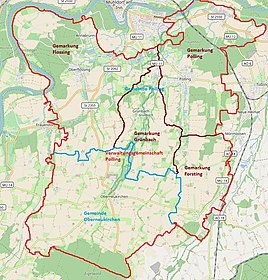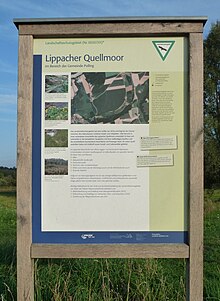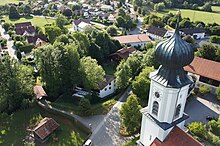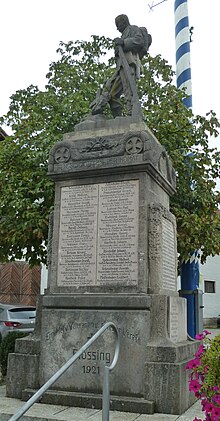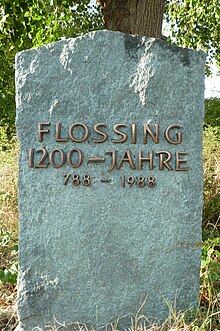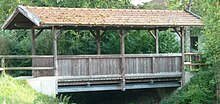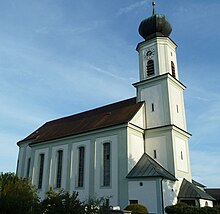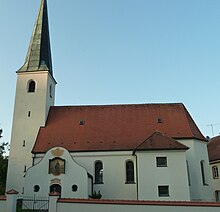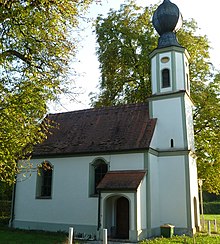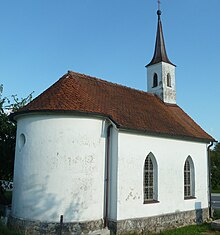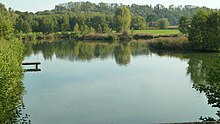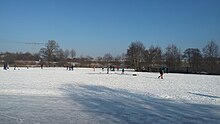Flossing
|
Flossing
Polling municipality
Coordinates: 48 ° 13 ′ 2 ″ N , 12 ° 30 ′ 18 ″ E
|
|
|---|---|
| Height : | 396 (380-460) m above sea level NHN |
| Area : | 16.03 km² |
| Incorporation : | January 1, 1972 |
| Postal code : | 84570 |
| Primaries : | 08630, 08631, 08638 |
|
Flossing (top left) within the Polling administrative community
|
|
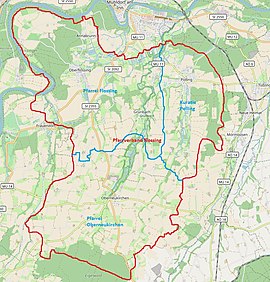
Flossing is a parish , a parish association and a district of the municipality of Polling in the administrative district of Upper Bavaria . Flossing is located on the southeastern side of the Inn, south of the district town of Mühldorf am Inn . It is made up of the upper and lower flossing. Km² with an area of 16.03 Flossing the largest municipal area of 43.85 km² and a total of four districts (Flossing Polling, Green Brook, Forsting) existing community polling . Before the incorporation, Flossing was a separate political municipality .
geography
Geographical location
Flossing is located in the Bavarian foothills of the Alps , north of the Chiemgau in the Inn-Salzach tourist region and the planning region of Southeast Upper Bavaria in the Bavarian chemical triangle , about 4 km south of the district town of Mühldorf am Inn .
geomorphology
The landscape of the Flossing district was formed in the course of the ice age glaciations. Today's landscape was primarily shaped by the Inn Glacier of Riss and Würm and their meltwater obtained by glacial and fluvial processes, the old and young moraine landscape formed. The border between the lower-lying tertiary molasse elements and the Ice Age gravel plains can be seen particularly well on the Flinz halfway up the Heistinger Inn-Prallhang, also known as the Hörndlberg. This is the last unobstructed impact slope of the Inn and the highest river impact slope in Europe at up to 45 m. The southern, higher part of the Flossinger Gemarkung area is located on the high Neukirchner terraces gravel field, a part of the Alzplatte , which was free of ice in the Würm and their up to 40 m thick Schottermoräne already in the Rißeiszeit formed. In a distinctive ridge with a height difference of more than 50 m, the terrain drops steeply in a line north along the districts of Gröben, Franking and Klugham onto the Worm-Ice Age young moraine terraces of the lower Inn Valley , on which the northern district with the main towns lies. Numerous springs emerge along the edge of the slope, most of which feed the Lippacher Quellbach (in the further course Flossinger Bach and Hammerbach) and in the Lippach area have led to the formation of a spring moor slope (landscape protection area No. 00207.01 spring moor slope near Lippach). At the foot of the spring slope, the water collected in a lake that has largely silted up to form a moor for about 150 years , which is why the area is still known today as the “Lippacher Seeleite”. The Inn glacier formed various terraced steps. 9 of these steps can be found in the municipal area, which with the exception of the high terrace (Neukirchner gravel field) were formed during the Würm Ice Age. The steps were named after the towns on them:
- Ampfinger stage
- Rauschinger level
- Ebinger level
- Wörther level
- Pürtener level
- Gwenger level
- Niederndorfer level
- Neukirchner high terrace
- Alluvions
While the village of Annabrunn is completely on the Niederndorfer step, Unterflossing is partly on the Pürten and partly on the Niederndorfer step; Oberflossing lies with the southern part on the Wörther step and with the northern part on the Niederndorfer step. The step change can be seen quite clearly here in the parish church of St. Johannes d. On the Wörther step . Anabaptist and the former mill property below on the Niederndorfer step, which uses the slope of the Flossinger Bach brook for energy. The millstone from Nagelfluh exhibited there , which was built into the foundation wall of the mill built in 1770, bears witness to the early use of grain mill technology at this point.
The "Flossinger Mountains"
Due to the elongated slope edges in the landscape that result from these terrace slabs, there are corresponding gradients on the roads and paths which they overcome.
In Oberflossing, the vernacular gave these slopes names:
- The “Kiama” mountain (= Kirchmaierbauer mountain) leads from Steinhölzl at “Kiama” to the center of Oberflossing.
- The "Pfarrer" mountain is the hill to the Pfarrstadl (when the vicarage was still a farm, a farm road led up to the Stadl).
- The "Muina" mountain (= Müller mountain), which overcomes the hill at the former mill property up to the center below the parish church.
- The Schmiedberg leads from the old forge of the agricultural machinery workshop to the street of the settlement area, which continues as Stürzlmooswiesenweg towards Hörndlberg.
- The Häuslerberg, named after the property there, branches off from the Schmiedberg and leads to the street of the settlement area, which continues towards Gweng.
Neighboring places
In the northwest, the Inn delimits the Flossinger area from the Ebing (town of Waldkraiburg ) and the Mühldorfer Hart (unincorporated), in the north, and the district town of Mühldorf am Inn directly in the north . In the southwest, the Gallenbach ( Frauendorfer Bach) partly forms the border with the Guttenburg district ( Markt Kraiburg am Inn ). In the northeast, a short stretch borders the Polling district ; in the east lies the district Grünbach ( municipality of Polling ), in the south the municipality of Oberneukirchen ( administrative community of Polling ).
Local division
Flossing itself consists of the districts of Ober- and Unterflossing. Overall, has district 25 districts:
climate
The climate in the Flossinger area is temperate but warm. There is a significant amount of rainfall, including the driest month (February). The climate classification according to Köppen and Geiger is Cfb. The annual average temperature is 8.3 ° C and the amount of precipitation is 938 mm, with climate change particularly noticeable in the Lower Inn Valley in the years after the turn of the millennium through falling precipitation and rising temperatures.
history
Antiquity and early history of Flossing (up to 6th century AD)
Bronze age
From the geological features (the former river bed of the Inn , filled up by the Flossinger Bach, in front of and in the Oberflossing area) it can be concluded that Flossing definitely had a ford over the Inn, which ran at that time. The settlement of the place goes back with high probability to the Bronze Age . The numerous finds from the Bronze Age and the Urnfield Culture confirm a settlement of the inner terraces around 1,800 BC. The ownership structure and naming of the Romanesque rulers also suggest that Flossing must be a very old settlement, where the Romans merged with the local, i.e. pre-Roman Celtic population.
Celts (Iron Age)
At the time of the Celts , Flossing was part of the Celtic Kingdom of Noricum , which stretched over large parts of what is now Austria and in what is now Bavaria reached from the southeast to the Inn . The Inn was an important transport route, in the Hallstatt and Latène times , especially for the salt extracted in its lower reaches from the mouth of the Salzach in the Alps , and later also for lime and limestone from the northern limestone Alps . Most sources ascribe the local area to the Alauni , one of thirteen tribes of the Celtic Noriker people . We still encounter the word alum today in a salt that is used to dye and tan leather .
Romans
15 BC The Kingdom of Noricum became a Roman province and thus part of the Roman Empire under Emperor Augustus . The province roughly encompassed today's Austrian federal states of Carinthia , Salzburg , Upper and Lower Austria , Styria and parts of Tyrol and south- east Bavaria including the Chiemgau as far as the Inn . The Inn as today's border between Flossing and Ebing formed the border between the Roman provinces of Noricum on the Flossinger side and Raetia on the Ebinger side.
Middle Ages (6th to 15th centuries AD)
Bavarians
At the end of and after Roman rule, the Bavarian tribe emerged . The exact historical origin is still disputed. It can be assumed that the tribe was formed from native Celts , remnants of the Roman population, and immigrant tribesmen of the Boiern . What is certain is that the lower terraces of the river valleys of the Danube and its tributaries, such as the Inn here, were first (re) settled after the Romans withdrew and that the Bavarians named their first settlements with the suffix -ing. Flossing is a so-called “real” ing village, the name comes from the early days of the Bavarian conquest of the land, although it can be assumed that parts of the naming were taken over from the Romanesque-Celtic. Similar to the ending syllables -ham and -heim from later times, the ending syllable -ing indicates someone or something that is at home in a certain place. Flossing could therefore be freely translated as “where the flowing water is at home” or “where the water flows from”. The name probably refers to the very old settlement in connection with the old Inn loop, the filling of this by the Flossinger Bach and in the first time probably by the Inn floods, as well as the ford .
First documentary mention
For the first time, Flossing was listed as a flozzingon in the “ Indiculus Arnonis ” list of properties of the first Salzburg Archbishop Arn (Arno) in AD 788 as a village with a parish church dedicated to St. John the Elder. Baptist is called. The fact that the last two sounds of these endings (-on, en) got lost in the course of time is due to the fact that the Bavarian and many other dialects "swallowed" these sounds, i.e. left them out. In Swabian, for example, these places usually still have the ending -ingen. Flossing is the oldest settlement within the administrative community of Polling . The consecration of the parish church to the patron saint Johannes d. Anabaptist points to a baptistery of the Bavarians at the time of Christianization.
The legend of the Hörndlberg
On the Hörndlberg, where the Inn broke a steep bank, stood the Hörndlbergschloss. The wild journeymen from Stampflschloss and Guttenburger Schloss attacked and plundered the Inn ships day and night. Worst of all, the Hörndlbergers are said to have had it at Flossing. If a ship had broken the iron chain that the rammers had stretched across the Inn, fire signals announced the Guttenburgers that the train was approaching. If a few barges went through the net, a horn reported the refugees to the Hörndlbergers and they dealt cruelly with the prisoners and did not shrink from murder . The Hörndlberger had the robbed shipmen nailed to the planks and pushed the ships back into the Inn. When this happened again, the doomed cursed their torturers in Hörndlberg. That same night the weather rose up, and lightning and thunder would not end. The next morning the Hörndlberg castle with all robber barons was swallowed up by the Inn.
Flossing in modern times (from 15th century AD)
Wars and hard times
Between 1632 and 1634 and 1648 Flossing also felt the horrors of the Thirty Years' War , also through the looting of its own soldiers.
According to legend , the Swedish troops in Altmühldorf planned to cross the Inn and plunder the neighboring Flossing at that time. They agreed to go off the next day with the Flossingen parish church ringing at eleven o'clock . The Altmühldorfer Mesner but learned from this project and reported to the Flossinger Mesner . He did not ring the eleven o'clock and the Swedes missed the attack. Flossing was spared. Since then there has been no more eleven o'clock ringing in Flossing.
Again and again there were disputes between Flossing, which belongs to Bavaria , and the city of Mühldorf, which was first mentioned in 935 AD and which belonged to Salzburg until 1803 . As early as 1557, boundary stones were set, which were replaced in 1665 by border pillars that bore the Bavarian coat of arms on one side and the Salzburg coat of arms on the other. At pillar no. 8 near Hammer there was the gallows on Flossingen's territory , on which criminals who the city of Mühldorf had to hand over to Bavaria were hanged. When a flood of the Inn in 1750 destroyed 100 days of the town of Mühldorf , the Mühldorf farmers cultivated the wasteland near Tegernau, which was previously used as pastureland by Flossinger and Mühldorf farmers. Thereupon the Flossingers, armed with scythes and flails , took the land forcibly into their possession and drove up all their cattle . A settlement was only reached in 1794 and the Tegernau was divided among the hostile neighbors.
In 1705, almost the entire village and the parish church fell victim to a devastating conflagration. Unfortunately, important documents of the parish , such as death and birth records, were also destroyed. The parish church was rebuilt in the following years and in 1720 again dedicated to St. John d. Consecrated Baptist .
The Bavarian-Austrian War of Succession brought hunger and war as well as murder , manslaughter and the plague to Flossing. As a result, there were numerous casualties among the Flossingen civilian population.
In the German Wars of Unification , Flossing had 16 soldiers and soldiers killed.
In the Mühldorf district, mobilization was ordered on August 1, 1914 at 8:00 p.m. During the First World War , the municipality of Flossing had 49 dead and missing.
The Second World War 1939 to 1945
As early as 1934, the NSDAP district leader made Polling the base for the communities of Flossing, Forsting, Grünbach, Mörmoosen, Polling and Oberneukirchen , which in 1938 before the beginning of the Second World War was elevated to an NSDAP locality group. Were made on Flossing and Annabrunn three bombing Americans , on November 4, 1944 January 8, 1945 and April 20, 1945. Several buildings were destroyed and there were lost three lives. This is shown by a US bomb dud hung up at the agricultural machinery workshop, which fell into a fish pond there. On May 7, 1945, the Americans marched into Flossing.
The community of Flossing had to mourn 93 dead and missing.
1954 flood
In July 1954, the region of southeast Bavaria was hit by a flood after prolonged heavy rainfall. The Flossinger Bach also flooded, and many properties were flooded.
Chernobyl 1986
After the disaster in the 4th reactor block of the Russian nuclear power plant Chernobyl , the region was exposed to not inconsiderable radioactive fallout in the form of radioactive rain due to the prevailing eastern weather. The consequences can still be felt today. For example, tubular mushrooms such as chestnuts are so contaminated with cesium-137 that consuming larger quantities is not recommended.
1991 flood
On August 1, 1991, Flossing was hit again by a serious flood disaster. After persistent, heavy local rainfall, the Flossinger Bach could no longer contain the water masses brought in via the Reichwinklgraben from the direction of Oberneukirchen . To make matters worse, a road passage between Reichwinkl and Klugham was blocked with debris , which caused the valley to fill up there; until the masses of water made their own way and tore away the entire street, so that the pent-up floods fell unhindered in one gush to Oberflossing. As a result, among other things, and through sections of the creek in the village of Oberflossing that were now piped during municipal road construction, the flood had worse effects than in 1954. Not only were the basements running, but the buildings on the ground floor, mostly located on the Niederndorfer step, partly full of water to the ceiling. Cars were washed away, the piles of wood stored in the sawmill in Annabrunner Strasse were scattered across the meadows towards Annabrunn. There was a lot of damage to property, but thank God there were no serious injuries or fatalities to complain about. In 1998, a flood exposure with a large flood retention basin was realized, which as Flossinger See invites you to swim in summer and to ice-skate and ice stick shooting in winter .
Flossing today
In 1988 Flossing was able to celebrate its 1200th anniversary (788-1988) with many events as part of a festival year. Numerous associations and citizens took part in the historical pageant.
Village renewal Flossing
Funded by the Office for Rural Development Upper Bavaria , a village renewal was carried out in Flossing between 1996 and 2006 with a high level of citizen participation and commitment . This was a clear benefit for the place in all respects. Many projects that the community had not yet started could be tackled and brought to a successful conclusion. So the school playground was finally designed to be child-friendly. After the bypass of State Road 2092 by the Rosenheim Road Construction Authority and the flood retention basin by the Rosenheim Water Management Authority, the redesign of the town center around the war memorial and the former main thoroughfare (Kraiburger Str.) Could be carried out. At the same time, the community also laid the sewage system in the village center. The course of the stream through the center of the village was also redesigned and renatured, the concrete edging was dismantled and replaced by bank reinforcement from Nagelfluh , and the many small stream bridges characteristic of Flossing were renewed. In the center of the village, the connection of the settlement area to the village center could be improved significantly through the creation of the "Kirchenbrückerl" over the Flossinger Bach, for this purpose the bypass brook was relocated and redesigned at the mill property. Overall, the place was able to significantly improve the quality of life .
Administrative affiliation
Flossing was part of the Burghausen Rent Office and the Mörmoosen Regional Court , which was later merged with the Craiburg Regional Court , of the Electorate of Bavaria . In the administrative reforms in Bavaria originated with the municipality edict of 1818 , the municipality of flossing.
In the course of the Bavarian regional reform at the beginning of the 1970s, the municipality of Flossing was assigned to the municipality of Polling (Mühldorf a. Inn) with effect from January 1, 1972 . On January 1, 1970, the community of Forsting and on July 1, 1970 the community of Grünbach were incorporated into the community of Polling . The main reasons for this development were economic reasons. While flossing could not meet due to lack of financial resources his duties at that time (it could hardly building areas are identified and the production of a central water supply failed), settled in Weiding in Pollinger community area with the Allgäu Alps Milch AG ( Bärenmarke ) of formerly the largest employer in the district of Mühldorf , so that Polling was one of the highest-income communities in the district at that time .
Due to the incorporation, the place is hardly of any importance compared to its history. Since the community wanted to concentrate all public facilities in Polling and the dissolution of the school site in Flossing is being pursued from various sides, there has been resentment among the population and efforts to regain local independence. The dispute over the location of a day nursery in 2018, which will be built at the Polling site following citizen and council decisions , also contributed to the lasting division of the population.
politics
Mayor of the municipality of Flossing
| Period | mayor |
|---|---|
| 1836-1838 | Lorenz Bachmann |
| 1838-1854 | Josef Kaltner |
| 1854-1858 | Schmidinger |
| 1858-1861 | Josef Lohner |
| 1861-1864 | Sebastian Schönhuber |
| 1864-1867 | Josef Lohner |
| 1867-1873 | Josef Oberstarr |
| 1873-1876 | Johann Kaltner |
| 1876-1884 | Jakob Schmidinger |
| 1884-1888 | Franz X. Scheitzach |
| 1888-1925 | Georg Schuhbeck |
| 1925-1936 | Josef Schmidinger |
| 1936-1945 | Johann Kaltner |
| 1945-1948 | Georg Galneder |
| 1948-1971 | Johann Kaltner |
Population development
| year | Residents |
|---|---|
| 1838 | 545 |
| 1861 | 649 |
| 1939 | 838 |
| 1945 | 800 |
| 1946 | 1183 |
| 1947 | 1380 |
| 1950 | 1219 |
| 1961 | 923 |
| 1970 | 917 |
| 1972 | 950 |
| 1987 | 910 |
The temporary increase in the post-war years is due to the large number of refugees who have been displaced . After the incorporation, the population continued to decrease. The population of Moos, which is part of the district of Polling and part of the district of Flossing, was extrapolated after 1972 in relation to the population at the time of incorporation (31.5% Flossing, 68.5% Polling). Since the municipality of Polling does not publish any population figures for districts or districts and after 1987 also the Bavarian State Statistical Office no longer publishes, more recent figures are not available. Due to brisk construction activity from the 1990s in Oberflossing and Unterflossing as well as Annabrunn, the 1000 mark is likely to have been exceeded again by now. For the current number of Catholics in the parishes see under “Parish and Parish Association Flossing”.
Parties and political groupings
- Christian Social Union (CSU) - local association Flossing
- Junge Union (JU) - local association Flossing
- Free voters (FW) - Local Association Polling-Flossing
religion
History of religion
During the Celtic period, the inhabitants of the Celtic religion and Celtic rites followed, the tribal god was Alaunus . When the Celtic Kingdom of Noricum became part of the Roman Empire around 15 AD, the Roman religion became the state religion here too , until Christianity was elevated to the state religion in the Roman Empire in 380 AD . Since the Noriker were the only Celtic people who were not forcibly integrated into the Roman Empire and Noric steel was the most important weapon material, one could retain a lot of freedom. With the Bavarian colonization, Germanic religions and burial rites also found their way into the area. From 615 AD the transition to Catholicism began with the proselytizing of Irish-Scottish monks and Catholic dioceses were founded in the Bavarian duchy . The oldest of them is the diocese of Salzburg , founded in 696 , to which Flossing originally belonged with its baptistery mentioned in 788. Today Flossing is part of the Archdiocese of Munich and Freising .
The Lutheran Reformation had hardly any impact in Flossing. Around 1530 Anabaptists made talk of themselves. A Anabaptist is mentioned on a farm in Moßhaim (= Obermoosham). The Anabaptists belonged to the Hutterite denomination , which had to emigrate to the United States of America and Canada and still speak a Bavarian dialect there today .
Religion today
The vast majority of the population today is Roman Catholic and only a small proportion Protestant , even if the wave of withdrawals from the churches does not stop at the parish of Flossing. Since the current wave of immigration from Islamic countries to Germany, Flossing has also had a changing proportion of Muslims of the Shiite and Sunni Islamic faiths, although most of them migrate to larger cities after the asylum procedure has been completed.
Parish and Parish Association Flossing
The cath. Parish Flossing St. Johannes d. Anabaptist , first mentioned in 788 in the register of properties of the diocese of Salzburg , is the original parish of today's parishes in Flossing. (1176 Catholics) and Oberneukirchen (764 Catholics) as well as the Kuratie Polling (903 Catholics). The parish association Flossing thus has 2843 Catholics. From 1615 to 1803 the parish of Flossing was part of the collegiate monastery Mühldorf . In 1823, Oberneukirchen became a branch of Flossing, and in 1861 Oberneukirchen became an independent parish of St. Margareta . Polling already became a branch around the year 1600 and is today the Curatie Mariä Heimsuchung belonging to Flossing . In 1987 the two parishes and the curate were again merged to form the parish association Flossing. The parish administrator has his seat in the rectory in Oberneukirchen. The parish association Flossing belongs to the deanery Mühldorf in the Archdiocese of Munich and Freising .
Pastor of Flossing
- 1424 Petrus Rieger, plebanus
- 1486 Joannes Scheyrmayr, parochus
- 1499 Joannes Hofhenn, plebanus
- 1530 Erhard Dollinger
- 1540 Johanner Prockmayer
- 1544 Caspar Ausermayr
- 1545 Georgius Pernkopf
- 1558 Andre Grüßl
- 1578 Georgius Fraidt
- 1584 Casparus Lansprecht
- 1615 Simon Hoechensteiner
- 1615 Johannes Ächter
- 1635 Caspar Kolstaetter
- 1643 Georgius Greißl
- 1661 Michael Eisenschmidt
- 1685 Francis Angerer
- 1686 Johann Wolfgang Merxeisen
- 1692 Johannes Jakob Treitle
- 1694 Johannes Gspann
- 1708 Josef Soiderer
- 1720 Wolfgang Josef Schmidt
- 1736 Franziskus Edmundus Wieser
- 1742 Ignaz Erber
- 1769 Matthias Schauer
- 1772 Johann Erasmus Wimmer
- 1786 Josef Anton Reitmayr
- 1798 Ferdinand Ferchl
- 1832 Lorenz Sporrer
- 1836 Joseph Meisl
- 1855 Franz Jakisch
- 1857 Johann Baptist Eberl
- 1877 Anton Hearing
- 1882 Simon Wurzinger
- 1887 Simon Strobl
- 1897 Max Daiser
- 1913 Johann Baptist Denk
- 1925 Johann Mittermaier
- 1929 Jakob Eisgruber
- 1935 Franz v. Paul Wittschek
- 1948 Georg Eicher
- 1964 Simon Wieser
- 1971 Franz Xaver Obermaier
- 1987 Monsignor Ludwig Scheiel
- 1995 Sebastian Allram
- 2006 Armin Thaller
Parish branches
The Catholic parish of Flossing has two branches: St. Leonhard in Grünbach and St. Anna in Annabrunn . The Laurentius Chapel in Unterflossing is privately owned. The Kuratie Polling has a branch in Bergham.
Marian apparitions
At the Laurentius Chapel in Unterflossing there are said to have been several Marian apparitions in connection with the Italian seer Salvatore Caputa in 2017 and 2018, in which several hundred believers took part and which caused a stir in the press. The Catholic official church distanced itself from it after examination.
Infrastructure and public facilities
traffic
Traffic development
In terms of traffic, Flossing is accessible via State Road 2092 , which starts at junction 20 (Mühldorf-Nord) of the A94 federal motorway via Mühldorf a. Inn , Unterflossing and Oberflossing to Kraiburg a. Inn leads; and from there on via Wasserburg a. Inn , Bad Endorf and Prien a. Chiemsee to junction 107 ( Bernau a. Chiemsee ) on the A8 federal motorway . Continue on state road 2355 , which branches off from state road 2092 beginning at Oberflossing and leads via Oberneukirchen to Garching ad Alz on the B299 . The municipality of Polling can only be reached from Flossing via a poorly developed municipal road. The district town of Mühldorf can be easily reached by bike from Oberflossing via Annabrunn and Starkheim, but there is no bike path connection to the Polling district, as well as bike paths along the two state roads.
Local public transport
The cities of Mühldorf a. Inn and Waldkraiburg as well as the market Kraiburg a. Inn are connected via the bus routes 6225 and 7509. The closest train station is Mühldorf (Oberbay) , the central hub of the Südostbayernbahn (SOB) .
Inn shipping
The Inn , once the most important transport route, no longer plays a role in traffic. In the years 1854 to 1858 even steamboats operated between Passau and Rosenheim . The changing water level, many days of fog and the emerging railroad brought about the end of the Inn shipping towards the end of the 19th century.
Public facilities
Municipal institutions
schools
Flossing has a primary school built in 1852/53 by the municipality of Flossing as an elementary school , in which the children of the school district Flossing ( municipalities of Flossing and Grünbach) were taught until 1966 . In 1966 the school district was assigned to Flossing Polling . The first and second grades of the municipality of Polling are currently being taught in the listed tuff stone building . Again and again, however, there are efforts on the part of Polling to dissolve the Flossinger School .
Kindergartens, day care centers and crèches
Flossing has no kindergarten or day-care centers , although it has been in a building area for a long time (but never realized) . Children can visit the municipal kindergarten in Polling , approx. 4 km away , or have places in municipal and church kindergartens in the nearby district town of Mühldorf a. Inn instructed. Flossing does not have a day nursery . A crèche is being built in Polling after a citizen and council decision .
Playgrounds and football fields
A children's playground and a football pitch are available in Nelkenstraße.
Church institutions
Parish home
In the historic, renovated Pfarrstadl of the parish of Flossing, a larger parish hall is available to the population for all kinds of meetings and gymnastics events. In addition, the premises of the Catholic rural youth (KLJB) Flossing as well as meeting rooms for the church choir, parish council and church administration are located in the building . Since the municipality of Polling in Flossing does not have a school gym, the Catholic gymnasium is available for the pupils of the primary school in Flossing. Parish Flossing in the Pfarrstadl available for physical education.
Shooting range
The Hörndlbergschützen Flossing e. V. operate a 50 m small and large-caliber shooting range as well as a 10 m air rifle shooting range including a clubhouse in Kraiburger Strasse.
Mini golf
The mini golf course Hammer in Seeor is the largest of its kind in Bavaria. In addition to the mini golf course with 17 lanes, a play golf course with 18 lanes, a miniature golf course with 18 lanes, a pit-pat facility with 18 tables and a trick pin facility with 12 stations are available.
Tourism, festivals and attractions
tourism
Flossing is located in the Inn-Salzach tourist region . The south-eastern variant of the Inn cycle path leads through Oberflossing and Annabrunn, and the region is accordingly characterized by so-called "gentle" tourism. A holiday farm in Gröben is available for overnight stays.
Due to the natural beauty of the landscape, the Flossinger area is increasingly becoming a recreational area for the growing district town of Mühldorf . Flossing can also be easily reached by bike or on foot in the middle of relaxing nature via the Innaue nature trail and the Inn ferry from Mühldorf to Starkheim .
Flossinger See
The Flossinger See is the largest resting body of water in the Mühldorf district . Created as a flood retention basin and designed for a so-called 100-year flood, the lake is often used as a bathing lake in summer by the local and foreign population , admission is free. Due to its nature, the lake is not an official EU bathing water , but the water values are regularly checked by the health department at the Mühldorf district office . Thanks to the cooling fresh water supply through the Flossinger Bach and the fish stocking controlled by the Mühldorf-Altötting district fishery, the values were perfect even in the hot and dry summer of 2018. In colder winters, when the ice cover is stable, the lake is used extensively for ice stock sport , ice hockey games and ice skating , or just for walking.
The Prandt
The Prandt, today known as the Flossinger Forest in most parts , is a larger, contiguous forest area, which starts at the Innbrücke Mühldorf and runs south-east of the Inn over the Tegernau, Starkheim, Annabrunn, Oberflossing, to Heisting, where there is a (Hallway Spitzbrand) ends. Around 135 ha of this are state forest (Flossinger Forest ) and around 257 ha are small-scale private forest. There are excellent hiking opportunities along the Inn in wonderful nature between Mühldorf a. Inn and Kraiburg a. Inn .
Recurring festivals
In addition to many parish, club and group festivities, Flossing has two annually recurring festivities:
The Flossinger village festival
The village festival, which has been taking place for four days from the holiday of Ascension Day for decades , is not only very popular with the local population. The rush of visitors is often immense, especially on Father's Day . During the festival there is usually a youth disco, a cabaret evening, a Schafkopf or Watt tournament, a children's afternoon and a classic car meeting. The festival, which traditionally begins with a booth concert in the center of the village and a subsequent procession to the festival area at the fire station, is organized by the Flossing volunteer fire brigade and the Hörndlbergschützen Flossing e. V.
Forest festival
The cycling association “All Heil” Flossing organizes the forest festival every year on a weekend in June, which has an even longer tradition than the village festival and was held for the first time in 1972. In contrast to many other forest festivals, the festival actually takes place in a forest, the so-called "Neuwirtshölzl", an oak forest between Oberflossing and Annabrunn. The festival in this natural setting is particularly popular with families and children.
Attractions
- The parish church of St. Johannes d. Consecrated in 1720 and built in baroque style . Baptist , Oberflossing
- Pilgrimage Church of St. Mother Anna, Annabrunn
- St. Laurentius Chapel, Unterflossing
- List of architectural monuments in Oberflossing
- Hörndlberg, Heistinger Inn-Prallhang, geotope no. 183R010
Trades and clubs
Business
To craft , trade and industry Flossing currently has (as of 2019) about: a holiday farm, a natural stone trade, a bus company, a landscaping operation, an automotive electrical company, a car repair shop, car upholstery, two insurance offices, a bank branch , a grocery store (village shop), a gift shop, an agricultural warehouse, two electrical installation companies, two small hydropower plants, two biogas plants, a beverage shop with party service, a barber shop, an agricultural and construction machinery workshop, an agricultural service (milking & cooling technology), a trailer rental Architectural office, a mini golf course, a haulage company, several agricultural contractors, a gravel pit, a fish farm, a carpenter's workshop, a psychological practice, a bicycle and mattress distributor, and numerous farms.
societies
There has always been a high level of club involvement in Flossing. In addition to the voluntary fire brigade, the clubs with the largest number of members, which are also of national importance, are the cycling club “All Heil” Flossing e. V., which organizes the annual forest festival, the Hörndlbergschützen Flossing e. V., which together with the fire brigade organize the annual village festival, as well as the tennis and ski club (TSC) Flossing e. V.
The clubs in detail:
- Flossing Volunteer Fire Brigade
- DJK Flossing
- Ice runners Annabrunn / Ried / Gweng
- Garden friends flossing polling
- Hörndlbergschützen Flossing e. V.
- Catholic women's community Flossing
- Catholic rural youth Flossing
- Warrior, reservist and soldier comradeship (KRSK) Flossing-Grünbach
- Lion Friends Flossing
- Marian Men's Congregation Flossing-Grünbach
- Mother-child group Oberflossing
- Cycling club "All Heil" Flossing, including the department of stick and ice shooters
- Schnupfer Club "Gut Pris" Flossing
- Sano e salvo consciously healthy e. V. Seeor
- Shooting club Flossing
- Flossing senior club
- Tennis and Ski Club (TSC) Flossing e. V.
Web links
- Polling municipality (Mühldorf a. Inn district)
- Interactive map display Flossing
- Historical maps of the Bavarian State Library in Flossing
Individual evidence
- ↑ Inn-Salzach: Treasure. Country. Flow. Zweckverband Erholungs- und Tourismusregion Inn-Salzach, accessed on September 3, 2018 .
- ^ Spring slope moor landscape protection area near Lippach. District Office Mühldorf a. Inn, accessed August 30, 2018 .
- ↑ a b c d e f g h i j k l m n o p q r s Arnold Dietl, Hans Landenhammer, Georg Hager: Heimatbuch Polling Oberneukirchen with the communities Polling, Forsting, Grünbach, Flossing and Oberneukirchen . Ed .: Verwaltungsgemeinschaft Polling. 1st edition. Greipel-Offset, Haag i. OB, Polling 1990.
- ↑ Climate Oberflossing: Weather, climate table, and climate diagram for Oberflossing. Retrieved August 30, 2018 .
- ↑ Climate diagram. Retrieved September 18, 2018 .
- ↑ Temperature diagram . Retrieved September 18, 2018 .
- ↑ The Alauni - Alauni . In: Alauni . ( alauni.org [accessed August 30, 2018]).
- ↑ Hörndlberg. Retrieved September 1, 2018 .
- ↑ Hans Rall: Time tables on the history of Bavaria . Süddeutscher Verlag, Munich 1934.
- ↑ Bosl's Bavarian biography . Friedrich Pustet, Regensburg 1983.
- ^ Hans Urzinger: Peasant uprising in the districts of Mühldorf 1633/34 .
- ^ Hans Urzinger, Josef Dirscherl: From the city and district of Mühldorf 1632/34 . Issues 1 and 2. D. Geiger, Mühldorf 1930.
- ↑ Michael Mauerberger: The peasant rebel in Das Mühlrad . Ed .: Heimatbund Mühldorf. tape IX . D. Geiger, Mühldorf 1959.
- ↑ The death register of the parish Flossing .
- ↑ Hans F. Nöhbauer: The Chronicle of Bavaria . Dortmund 1987.
- ↑ Denk-Weiß: Our Bavaria region . Munich 1906.
- ↑ a b c Polling-Oberflossing, Mühldorf a. Inn, Bavaria. Retrieved September 1, 2018 .
- ^ Flood disaster 1954 - LfU Bavaria. Retrieved September 11, 2018 .
- ↑ Increase quality of life, promote development - this is how communities and villages become fit for the future. Retrieved September 5, 2018 .
- ^ A b Raphaela Lohmann: Elementary school under one roof. Oberbayerisches Volksblatt, November 7, 2017, accessed on August 30, 2018 .
- ↑ a b Exciting topic of the day nursery: Heated spirits during the viewing appointment . In: https://www.innsalzach24.de . April 14, 2018 ( innsalzach24.de [accessed August 30, 2018]).
- ^ Joseph Heyberger, Chr. Schmitt, v. Wachter: Topographical-statistical manual of the Kingdom of Bavaria with an alphabetical local dictionary . In: K. Bayer. Statistical Bureau (Ed.): Bavaria. Regional and folklore of the Kingdom of Bavaria . tape 5 . Literary and artistic establishment of the JG Cotta'schen Buchhandlung, Munich 1867, Sp. 180 , urn : nbn: de: bvb: 12-bsb10374496-4 ( digitized version ).
- ↑ Bavarian State Office for Statistics and Data Processing (Ed.): Official local directory for Bavaria, territorial status: May 25, 1987 . Issue 450 of the articles on Bavaria's statistics. Munich November 1991, DNB 94240937X , p. 116 ( digitized version ).
- ↑ a b c d e f g Parish Flossing. Retrieved September 18, 2018 (German).
- ↑ a b c d Statistics, numbers. Retrieved September 18, 2018 (German).
- ^ Parish of Oberneukirchen. Retrieved September 18, 2018 (German).
- ↑ a b c Parish of Polling. Retrieved on September 6, 2018 (German).
- ↑ Pfarrverband flossing. Retrieved September 18, 2018 (German).
- ↑ Around 300 people with the alleged apparition of Mary . In: Der Tagesspiegel Online . March 17, 2018, ISSN 1865-2263 ( tagesspiegel.de [accessed September 4, 2018]).
- ^ Polling, Oberflossing, Polling (Mühldorf a Inn district): departure and arrival. Retrieved September 4, 2018 .
- ↑ Inn shipping Schärding. Retrieved September 4, 2018 .
- ↑ Hörndlbergschützen Flossing e. V. Retrieved September 18, 2018 .
- ↑ Inn Cycle Path | Welcome to the Inn Cycle Path. Retrieved on September 19, 2018 (German).
- ↑ CSE Kraus and Straubinger, Klausenstr. 29, 84489 Burghausen, www.cse-online.de: Naturerlebnisweg Innaue Mühldorf a. Inn. Retrieved September 18, 2018 .
- ↑ Inn ferry | Stadtwerke Mühldorf. Retrieved September 18, 2018 (German).
- ↑ District fishing association Mühldorf Altötting. Retrieved September 18, 2018 (German).
- ↑ From the city and district of Mühldorf . Booklet 4. D. Geiger, Mühldorf.
- ↑ Start of the picture book for the 38th Flossinger Village Festival . In: https://www.innsalzach24.de . May 11, 2018 ( innsalzach24.de [accessed September 18, 2018]).
- ↑ Forest Festival Flossing. Oberbayerisches Volksblatt, June 13, 2018, accessed on September 18, 2018 .
- ↑ Heistinger Inn-Prallhang, pdf download. Retrieved September 18, 2018 .
- ↑ Associations. Retrieved September 6, 2018 .
